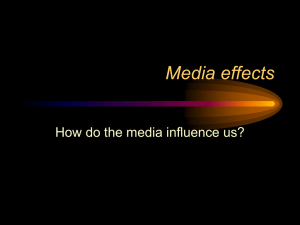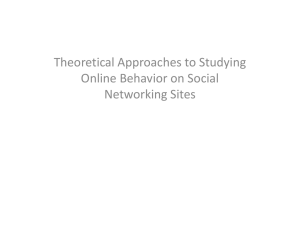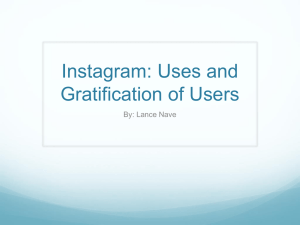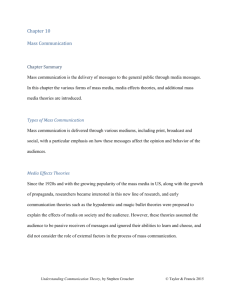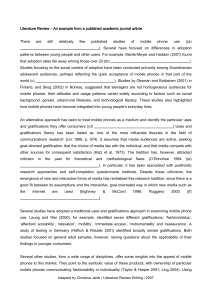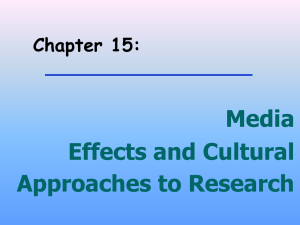Harwood_Vincze JSI Transylvania - U-System
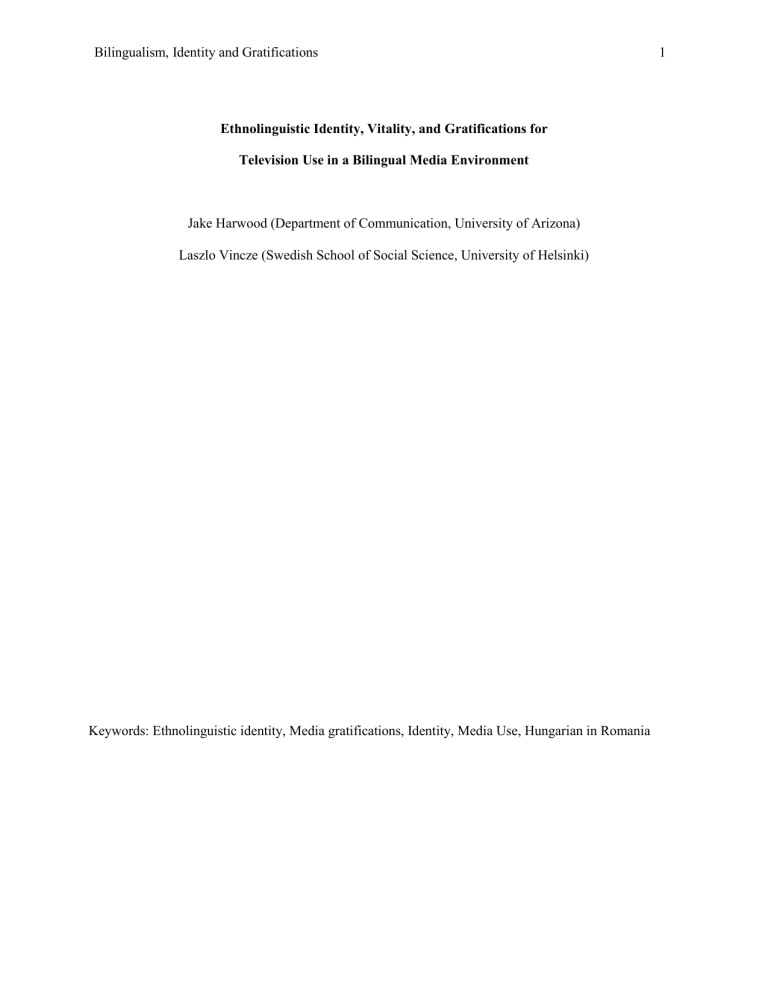
Bilingualism, Identity and Gratifications
Ethnolinguistic Identity, Vitality, and Gratifications for
Television Use in a Bilingual Media Environment
Jake Harwood (Department of Communication, University of Arizona)
Laszlo Vincze (Swedish School of Social Science, University of Helsinki)
Keywords: Ethnolinguistic identity, Media gratifications, Identity, Media Use, Hungarian in Romania
1
Bilingualism, Identity and Gratifications 2
Abstract
The paper presents and tests a model predicting minority language television consumption. We examine how four media gratifications (diversion, social identity, surveillance, parasocial companionship) mediate the relationship between ethnolinguistic identity and choice of ingroup language television viewing. The study is performed among (minority) Hungarian-speakers in Transylvania, Romania. Selfreport questionnaire data from 401 Hungarian-speaking high school students in Csíkszereda/Miercurea
Ciuc (a majority Hungarian locale) and Brassó/Bra ș ov (a minority Hungarian locale) allowed us to compare high and low local vitality conditions. Analysis indicates that diversion (entertainment) and ethnolinguistic identity motives for watching ingroup language television are the strongest mediators of the influence of identity on ingroup language television use. We examined four moderators of these indirect effects (objective vitality, subjective vitality, intergroup contact and intragroup contact). The moderators revealed a number of rather complex effects which are discussed with regard to the local intergroup context and broader issues of media and intergroup relations.
Bilingualism, Identity and Gratifications 3
Ethnolinguistic Identity, Vitality, and Gratifications for
Television Use in a Bilingual Media Environment
The goal of the present paper is to explore the role ethnolinguistic identity plays as a motivational factor in the television use of minority group bilingual audiences. We address how ethnolinguistic identity guides linguistic preferences in television use among minority language speakers, and the ways in which that relationship is mediated by specific gratifications for seeking media. We also examine ethnolinguistic vitality as a key moderator of those connections.
Our subjects are minority Hungarian speakers in Transylvania (Romania), but we discuss applications of the results to other minority language situations, including in the United States.
Uses and gratifications theory examines the reasons people selectively seek specific media
(and avoid others) based on the needs that viewers perceive media will meet. Traditional gratifications investigated include diversion (entertainment), surveillance and information gathering, as well as (para)social interaction and companionship. However, gratifications connected to social (group-level) identity concerns have also been investigated, particularly via the social identity gratifications perspective (Harwood, 1997, 1999). Social identity gratifications suggest that identifications with social groups (Tajfel & Turner, 1986) can motivate seeking of specific media content, and that media used in this way can support or reinforce specific identities. Harwood proposed that individuals seek media depictions that “strengthen their identification with a particular social group and/or make that identification more positive”
(Harwood, 1999, p. 123). Research has supported this proposition regarding age (Harwood, 1997,
1999), gender (Trepte, 2004) and ethnic identity (Abrams, 2010; Abrams & Giles, 2007, 2009).
Identity gratifications explain some age differences in genre preference (Mares & Sun, 2008), as well as the role of gender (Knobloch-Westerwick & Hastall, 2006), age (Knobloch-Westerwick
Bilingualism, Identity and Gratifications 4
& Hastall, 2006; 2010) and race (Knobloch-Westerwick, Appiah, & Alter, 2008) in news selection.
Our research extends this work to examine the language -based media choices of minority bilingual individuals in a bilingual environment. While age, gender and other social identities appear in the content of television programs through the physical characteristics of the characters, language is present not only in characters but also as the channel between text and user. Thus, in choosing between minority and majority language media channels, the chooser is making a fundamental choice concerning messages that represent and transmit group-identity-relevant messages in a fully saturated manner (Harwood & Vincze, 2012). Hence, we might anticipate stronger identity-related media consumption patterns with linguistic than non-linguistic identities.
As discussed next, while some areas are more bilingual than others, minority language group members exist in the vast majority of social contexts and minority language media are increasingly available universally, and hence the processes discussed here apply equally well to an isolated Swahili speaker in Albuquerque, New Mexico or a Spanish speaker of Mexican origin living in an East LA barrio.
Although this particular study examines a minority language context in Europe, it should have clear-cut application to minority language media use in other contexts. As discussed by
Ortiz (in press), Spanish language media are prevalent in the United States, with most cable television subscribers having access to a number of Spanish language outlets. Indeed, the power of minority media in a largely immigrant culture such as the United States is clear, and the historical trajectory of such media is now well-documented (Browne, 2008). Theoretically, Kim
(1988) notes the relevance of minority media in acculturation among immigrant groups to the
United States, with high native-language media users exhibiting difficulties in adjusting to the
United States; the perspective has gained support in research on multiple ethnic groups (Raman &
Bilingualism, Identity and Gratifications 5
Harwood, 2008) and on new as well as old media (Wang & Sun, 2009) within the United States.
Of course, recent developments in the availability of social media, internet television, and satellite television mean that access to minority language media is shifting dramatically and in many cases becoming considerably easier (Jones & Uribe-Jongbloed, 2013). As such, many media environments that might previously have been considered monolingual are now bilingual, and only the most isolated areas without Internet access could still be considered solidly monolingual.
We explore how traditional media gratifications mediate the link between ethnolinguistic identity and selection of ingroup media. We predict that identity is associated with selection of ingroup media—people strongly connected with their group will prefer ingroup media that support and enhance their identities. Those less connected to their group will be more open to consuming outgroup media; the most disidentified might prefer outgroup media (Harwood &
Roy, 2005; Reid, Giles, & Abrams, 2004). One specific mechanism through which this occurs should be through traditional and social identity gratifications. Perhaps most obviously, identities should drive social identity gratifications, which will then drive outgroup media. However, to the extent that media are identity-saturated in the linguistic context, even gratifications such as surveillance should be identity-linked. Identities drive preferences for ingroup versus outgroup media to the extent that those media are seen to provide information relevant to the individual.
For strong minority group identifiers, ingroup media will be seen as more likely to yield entertainment and diversion as a function of the perceived relatability of those media and the absence of outgroup threat present in them; likewise ingroup companionship functions should be more salient to high ingroup identifiers. Hence, we examine the ways in which media gratifications mediate the connection between identity and ingroup media use (Figure 1).
Moderators
Bilingualism, Identity and Gratifications 6
We predict that three intergroup variables will moderate some of the paths in Figure 1.
Ethnolinguistic vitality has been defined as that which “makes a group likely to behave as a distinctive and collective entity within the intergroup setting” (Giles, Bourhis & Taylor, 1977, p.
308). Objective vitality comprises the structural elements in the local environment contributing to group strength (demographics, institutional influence, social status). Groups stronger in these elements have higher objective vitality and are more likely to persist, thrive, and dominate.
Subjective vitality is the individual’s assessment of group vitality (Bourhis, Giles & Rosenthal,
1981; Harwood, Giles & Bourhis, 1994). While linked to objective reality, subjective vitality demonstrates interindividual variation, which in turn explains outcomes for those individuals and their groups (e.g., in terms of language attitudes/behaviors: Bourhis & Barrette, 2006; or linguistic survival: Giles & Johnson, 1987). We predict that vitality (objective and/or subjective) will moderate the links in our model. In low vitality situations, threat to the ingroup’s survival is perceived as greater and hence we expect stronger links between identity and specific media gratifications, and in particular we expect a greater mediating influence of social identity gratifications, as compared to high vitality situations. Intergroup contact’s influence on attitudes about groups has been extensively examined in recent years (Pettigrew & Tropp, 2006, 2008). An influential perspective suggests that contact between members of different groups leads to deprovincialization—a tendency to adjust one’s view of the ingroup and conclude that ingroup norms, values, and behaviors are not the only “right” way to do things (Brewer, 2008; Pettigrew,
2011). In the media context, contact-induced deprovincialization should reduce identity-related influences on media choices as people become more willing to expose themselves to new ideas.
However, extensive intergroup contact might serve to enhance perceived threat from the outgroup and lead to a desire to compensate via ingroup media outlets. Hence, we believe that intergroup contact will moderate the links in Figure 1, but are unsure of the direction. Finally, we consider
Bilingualism, Identity and Gratifications 7 intragroup contact.
Ingroup networks function as identity-support mechanisms (Gaudet &
Clément, 2009). In a sense they are the opposite of intergroup contact, however having high levels of inter- and intragroup contact are not mutually exclusive. Hence, we examine the extent to which seeking intragroup contact either encourages identity-related media seeking (via a more general identity-enhancement mechanism), or reduces it (i.e., if identity-related needs are being met interpersonally, then there is less need for them to be met in the media).
Hungarian in Transylvania
In terms of ethnolinguistic vitality (Giles et al., 1977), Hungarian in Transylvania presents a case in which moderately good demographic capital is accompanied by low status and weak institutional support. The proportion of Hungarians in Transylvania has continuously decreased since the region became a part of Romania in 1920, but the census of 2002 found that 6.6% of the country’s population (1,434,000 people) are ethnic Hungarians. The Hungarian minority lives in
Transylvania, a traditionally multilingual territory. In the western part of the region their proportion varies between 5% and 30%, and in the Eastern part they make up 70-90% of the local population. Hungarian has no official status in Transylvania. According to Romanian public administration law (2001/215), local administrative authorities should allow the use of the minority language in their own affairs in administrative units in which more than 20% of the population belongs to a minority group. However, research shows that the linguistic rights guaranteed by the law are rarely supported in practice (Péntek & Benő, 2003). Support for the language in formal institutions is lacking, but there is a Hungarian school system in Romania.
The situation of Hungarian in in formal institutions such as churches, theatres and other cultural institutions is considerably better than in formal or government institutions.
There is no state-run Hungarian language television channel in Romania; Romanian Public
Television airs six and a half hours a week in Hungarian (somewhat less than 1% of total
Bilingualism, Identity and Gratifications 8 broadcasting time). This programming focuses primarily on news and cultural programs, particularly “high” culture and traditional folklore; it is produced by Hungarians, but may be of limited appeal to the local young population. A large representative survey among young
Hungarians in Transylvania showed that 54 percent of the participants never watch the Hungarian programming of Romanian Public Television, and 32 percent said that they watch it less than once a month (Kiss, Barna, & Solyom, 2008). The majority of Hungarian language television consumption occurs by watching Hungarian language channels from Hungary. The availability of these channels is not institutionally and centrally organized, and therefore depends on varying packages provided by local service providers. Some of this content is locally produced Hungarian media, but it also includes dubbed material from elsewhere in Europe and the USA. One public
TV channel in Hungary (Duna TV), focuses on Hungarian minorities in the neighboring countries and has maintaining Hungarian culture outside of Hungary as part of its mission. It broadcasts a variety of programming, much of which contains messages explicitly designed to maintain and support Hungarian cultural identity in the diaspora. It has three regional studios in Transylvania.
However, the other Hungarian TV channels, including the commercial ones, pay little attention to
Hungarians outside of Hungary’s borders. This information concerning the availability and origin of minority media is provided both to situate the immediate context of our research, and to suggest other parallel contexts to which our findings might more smoothly apply. Clearly, the media availability for Hungarian speakers in Romania is quite different from that for Spanish speakers in the Southwestern United States who can easily access multiple television and radio channels in Spanish carrying content produced in the United States as well as imported from other countries. However, Hungarian in Romania might be quite similar on a number of dimensions to, for instance, French in New England. Francophone New Englanders might have a
Bilingualism, Identity and Gratifications 9 local newspaper published in French, but beyond this they will probably rely on cross-border media for broadcast French language content.
Method
Self-report questionnaire data were collected from Hungarian-speaking youth in
Csíkszereda/Miercurea Ciuc and Brassó / Bra ș ov in October 2011. The research was conducted in secondary schools where the language of instruction was Hungarian ( N = 401). Respondents were between 15 and 17 years old. Seven cases (6 girls, 1 boy) were deleted because they reported that both parents were majority (Romanian) speakers (final N = 394). Of the respondents, 60% were females (40% male); 94% had two Hungarian-speaking parents, while 6% had one Hungarian-speaking and one Romanian-speaking parent.
Measures
Independent Variable: Ethnolinguistic identity. Identification with the minority language group and the majority language group was measured by three 5-point items for each.
Two of the items were based on Doosje, Ellemers, and Spears (1995; e.g., “I feel strong ties with
Hungarian/ Romanian speakers”). We added a third item focused on linguistic identification (“I feel that the Hungarian/Romanian language is my mother tongue”; Cronbach’s α
= .74 for
Hungarian, α = .81 for Romanian). We subtracted Romanian-speaking identity from Hungarianspeaking identity to yield a measure of relative Hungarian-speaking identity strength (range = -4 to 4; M = 2.99, SD = 1.29). Overall, Hungarian ethnolinguistic identity was fairly high.
Dependent Variable: TV language. Language of television use was measured by three items. Relative TV language was measured by a five-point scale from “only Romanian” to “only
Hungarian”. Frequency of Hungarian and Romanian language TV use, respectively, were assessed with two five-point scales (“almost every day”, “more times a week”, “once a week”,
“more seldom” and “never”). The Romanian item was reverse-scored so that high scores
Bilingualism, Identity and Gratifications 10 indicated using less Romanian television, and then the three items were averaged to create an overall measure of minority language television viewing. We do not report an alpha statistic for this measure because amounts of Hungarian and Romanian television viewing are positively correlated (presumably as a function of overall affinity for television) and hence they are negatively correlated once the Romanian item is reverse scored. This results in the unusual situation of combining two negatively correlated items into a composite measure; however the logic of combining these items is sound and the composite score constitutes a face-valid indicator of relative preference for Hungarian over Romanian language television.
Mediator Variables: Motives for TV use. Participants were asked about the reasons for
Hungarian- and Romanian-language TV use separately based on commonly used measures in the uses and gratifications literature (e.g., Ruggiero, 2000) including surveillance (seeking media for information), diversion (seeking media for entertainment) and parasocial companionship (seeking media for social companionship). Based on Harwood (1999), we also assessed mediated intra- and intergroup contact (e.g. “…to have contact with Hungarian/Romanian speakers”) as a reason for TV use. All motives were measured with three five-point items for Hungarian and Romanian language TV use alike. The reliability of most of the compound scales was good (diversion
Hungarian α = .78 Romanian α = .89; surveillance Hungarian α = .78, Romanian α = .85; mediated group contact Hungarian
α
= .79, Romanian
α
= .80). Parasocial companionship had reasonable reliability in Romanian (
α
= .78), but not in Hungarian. Therefore, for Hungarian we used a single item (“I watch Hungarian language television so I won’t have to be alone.”). For each motive the Romanian score was subtracted from the Hungarian score to yield a relative measure of that motive for Hungarian relative to Romanian media use.
Moderator Variables. As explained earlier, three classes of moderator variables were of interest. Vitality is assessed both objectively and subjectively. Objective local vitality (Henning-
Bilingualism, Identity and Gratifications 11
Lindblom & Liebkind, 2007; Landry & Allard, 1994) refers here to the linguistic composition of the municipalities where we collected data: 50% of the respondents were from Csíkszereda /
Miercurea Ciuc, where 82% of the local population are Hungarians (“High objective Hungarian local vitality”), and 50% of the respondents were from Brassó / Bra ș ov, where Hungarians compose 8% of the local population (“Low objective Hungarian local vitality”). Subjective vitality was measured by twelve 5-point items from the subjective vitality questionnaire (Bourhis et al., 1981) asked separately concerning the ingroup and the outgroup. Four items gauged each of three vitality dimensions: perceived status (“How highly regarded are the following languages in Transylvania?”), demography (“In all parts of Transylvania where these groups live, to what extent are they in the minority or majority?”), and institutional support (“How often are the following languages used in Transylvania government services?”) within Transylvania. Internal consistency of the ingroup ( α = .84) and outgroup ( α = .81) scales was good. Subtracting the outgroup from the ingroup scale yielded a single measure of relative perceived ingroup
(Hungarian) vitality. Intergroup contact (contact with Romanian speakers) was measured with a single item. Participants indicated on a 5-point scale how often they have personal contact with members of the majority group (1 = “every day”; 5 = “almost never”). Intragroup contact was measured with three items: participants’ assessments of the linguistic background of their circle of friends, their own daily language use, and language use within their family (all measured on five point scales from “only Romanian” - “only Hungarian”). We averaged these three items to create a measure of the presence of Hungarian in the respondent’s daily life (
α
= .72).
Analysis
Analyses were performed using Hayes’ (2013) PROCESS macro for SPSS. Model 4 was used to test indirect effects, with all four media gratifications measures as simultaneous parallel mediators. For each mediator, bootstrapped 95% confidence intervals (CIs) for the indirect effect
Bilingualism, Identity and Gratifications 12 tested for significant mediation (CIs are significant when they do not contain zero; 5000 bootstrap samples were used). Model 58 was used to test for conditional indirect effects, simultaneously examining whether the first (IV-Mediator) and/or second (Mediator-DV) paths in the model were moderated by each moderator in turn. For significant moderators, indirect effects were examined at +1 and -1 SD of the moderator variable to understand the nature of the moderation. Parents’ educational level and sex were incorporated as controls in all analyses. Objective local vitality was controlled when it was not incorporated as a moderator.
Results
The test of the (unmoderated) mediated model is in Table 1. Our focal independent variable (identity) significantly and positively predicted diversion, social identity, and surveillance gratifications, and marginally positively predicted the companionship gratification.
In the second stage, identity retained a direct effect on Hungarian language television use, suggesting that any mediation observed is partial. Diversion significantly predicted the outcome, and identity and surveillance gratifications marginally predicted it. The critical tests of indirect effects are provided by the bootstrapped confidence intervals. As shown in the table, diversion and identity gratifications both significantly mediate the effects of identity on television viewing.
In terms of the control variables, sex and parent education were not significant influences on the model, except that parent education marginally predicted surveillance. Local objective vitality significantly and positively predicted gratification to use ingroup media for diversion and companionship, meaning that those gratifications were more prevalent in majority areas.
Objective vitality negatively predicted social identity gratifications for using ingroup media, indicating that this gratification was more salient for those living in minority areas. In terms of control variables, objective vitality significantly and positively predicted Hungarian language
Bilingualism, Identity and Gratifications 13 television preference, probably reflecting the greater supply of such media in the high vitality areas (and hence the value of this variable as a control).
Results of our moderator analyses are presented in Table 2 and discussed here in order of moderator variable. Nonsignificant statistics are largely excluded from the table to keep things interpretable (contact authors for complete information). Objective Hungarian vitality moderated only the link between diversion gratifications and the dependent variable (the second path in the mediated model). The conditional indirect effect from identity, through diversion motives to preferring ingroup media shows a stronger positive mediated pathway in low vitality areas than in high vitality areas. In other words, for individuals in a local minority, diversion motives transfer identity to ingroup media consumption more strongly than for those in a local majority.
Subjective vitality moderated links between identity and surveillance motives and the DV
(TV language use), although the latter is only marginally significant. The link through identity gratifications to the DV was strong and positive when subjective vitality was low, but nonsignificant when vitality was high. In contrast, surveillance motives facilitated a significant and positive indirect effect when subjective vitality was high, but no significant indirect effect when it was low. In other words, when subjective vitality is low, identity gratifications mediate the effects of ethnolinguistic identity on consumption of ingroup media; when vitality is high surveillance motives are more important in mediating the identity-ingroup media link.
Intergroup contact moderates the effect of diversion and surveillance on the DV. People with high levels of intergroup contact are driven to consume ingroup media by diversion motives more strongly than those with less intergroup contact, although both slopes are significant. For those with low intergroup contact, identity drives ingroup media preference through surveillance motives, a link that is nonsignificant among the high contact group.
Bilingualism, Identity and Gratifications 14
The moderating effects of int ra group contact are more complex. Intragroup contact moderates the link between identity and all four motives (only marginally significant for surveillance). Intragroup contact also moderates the links between two motives (diversion and surveillance) and the dependent variable (for diversion this effect is marginally significant). The global estimates of the conditional indirect effects emerging from these analyses (and reported in the table) were at times unclear, because effects on one pathway in the mediated model counteracted effects in the other. In those instances, we independently decomposed interaction effects for path 1 (identity
→ gratification) and path 2 (gratification
→ media use) using Model 1 in PROCESS (Hayes, 2013; full statistics available from the authors).
The overall conditional indirect effect for diversion is uninterpretable because the moderating effects of the two pathways in the mediated model are in opposite directions. The positive moderation of path 1 shows that the positive (and significant) effects of identity on diversion grow stronger with higher levels of intragroup contact. The negative moderation of the second path shows that the positive and significant effects of diversion on Hungarian media use get less strong with higher levels of intragroup contact. In other words, high levels of intragroup contact enhance the effect of identity on diversion motives, but then suppress the translation of those motives into actual ingroup media consumption.
The positive effects of identity on identity gratifications are stronger for those with higher levels of intragroup contact, although effects are significant at all levels of intragroup contact.
Again, the overall conditional indirect effects (reported in table) are unclear because of processes occurring in the second path (although moderation of the second path was not significant).
For surveillance, the two moderator effects are in a consistent direction. The more intragroup contact respondents have, the stronger the (positive) mediated path through surveillance to ingroup media preference; the path is not significant for people with low levels of
Bilingualism, Identity and Gratifications 15 intragroup contact. Surveillance motives are stronger mediators for people with higher levels of contact with their ingroup members.
Finally, the conditional indirect effect for companionship is only marginally significant and moderation is only suggested on the first path. Supplementary analysis of just that path suggests that the effect of identity on companionship gratifications is significant only for those with high levels of intragroup contact.
Discussion
Our analysis demonstrates that traditional and social identity gratifications mediate the effects of ethnolinguistic identity on preference for ingroup media, although in some cases only under the influence of specific moderators. Overall, diversion (entertainment) and social identity gratifications are the strongest mediators. Diversion mediates on its own, and its mediating effects are enhanced under conditions of low objective vitality and high intergroup contact. Identity gratifications also mediate the effect independent of moderators; identity gratifications’ mediating effect is enhanced under conditions of low subjective vitality, and high intragroup contact.
Surveillance motives do not independently mediate, but they do have mediator effects when subjective vitality is high, intergroup contact is low, and intragroup contact is high.
Companionship was the weakest gratification variable; results suggest that a need for (para)social connection is not a mechanism by which identity influences ingroup media selection. Further discussion focuses on briefly making sense of the pattern of moderator effects.
The effects of diversion are stronger under what could be construed as “minority” conditions, both objective (low objective vitality) and subjective (high intergroup contact, which relates to the subjective experience of being in a relative minority). In these settings, identity concerns translate into a stronger belief that ingroup media will be more entertaining than outgroup media, which in turn translates into more ingroup media use. Conceivably, minority
Bilingualism, Identity and Gratifications 16 status yields greater stress and threat from intergroup relations for those high in group identity, and so minority media offer (and provide) a place for diversion from perhaps stressful intergroup relations. Indirect support for this comes from content analyses of minority portrayals in the media. For instance, in the United States, minority groups are rarely portrayed positively and are often shown in a negative light in mainstream media (Mastro, Blecha, & Atwell Seate, 2011).
Hence mainstream media remind minority group members of their low status and as a result such individuals may actively avoid majority media (Abrams & Giles, 2007), and seek out minority media instead (Harwood & Roy, 2005). Where the group is closer to a majority, diversion perhaps can more easily be gained from in- or outgroup media. Notably, objective vitality is controlled in the effects for intergroup contact that we report. Therefore, those effects are not confounded with the effects of objective vitality, but relate to interindividual variation in intergroup contact within objectively similar minority/majority settings.
Our findings for social identity gratifications partially support this account. These gratifications become particularly salient under conditions of low subjective vitality, which again would reflect a perception of minority and low status. In such circumstances, one way in which identity drives ingroup media choices is (unsurprisingly perhaps) through perceptions that the media will support and reinforce one’s group identity. The stronger social identity gratification effects among people with more intra group contact are less consistent with this story. However, remember that these analyses control for objective vitality, and so reflect a level of intragroup contact relative to the objective availability of ingroup networks. Plausibly, high levels of intragroup contact reflect a broader desire for ingroup support that also manifests in identity driving a search for ingroup media characters.
The minimal effects for companionship are somewhat surprising, and do not reflect the zero order correlations in which companionship is substantially related to identity ( r = .23) and
Bilingualism, Identity and Gratifications 17 ingroup media selection ( r = .42). It is plausible that social identity gratifications for specifically ingroup contact in the media might swamp any unique effects from a companionship gratification. That is, to the extent that identity drives a desire for companionship, it drives a desire for companionship with ingroup characters and hence the desire for ingroup character companionship is subsumed by social identity gratifications motives. The effects for surveillance are also curious—where we might expect identity to drive information seeking in situations of greater uncertainty (e.g., low vitality, high intergroup contact), in fact the reverse appears to be the case (surveillance is a strong mediator in situations of high intragroup contact and high subjective vitality). There are two plausible explanations for this. First, surveillance may be more salient for people low in identification who may seek information to clarify their own uncertain positions of being members of minority groups but at least somewhat identified with the majority
(remember—our measure of identification is for ingroup relative to the outgroup). These individuals may experience most uncertainty and need for information when they are in a position that makes their identification with the outgroup hard to explain (lots of ingroup friends, high perceptions of ingroup vitality). Second, our measurement may be insufficiently sensitive. In particular, we do not know whether these people are seeking information about the in group or the out group. Effects on ingroup media preferences might be weakened by individuals seeking outgroup media to find out what “they” are saying about “us.” Minority group members probably sometimes consume majority media with a surveillance motive, but our measurement does not allow us to examine such strategic cross-group media use. Clearly, subsequent work in this content needs to examine more specific details of media content and use to understand not just the language of television use but the specific messages being consumed.
In a more applied sense, our results have implications for media consumers and producers.
For consumers, the results are a part of understanding media as functionally important elements
Bilingualism, Identity and Gratifications 18 in an ethnolinguistic landscape that either supports or undermines group identities. For those interested in maintaining diversity and supporting the continued existence of threatened languages and cultures, attention to the ways in which media support minority groups is essential.
Our work shows that ethnic identity drives media consumption, but not to as large a degree as might be expected. This effect is small because of the objective availability of media (you can’t use media that don’t exist), and due to individuals perceptions of the utility of the media (you won’t use media to support identity if you don’t see the media as identity-supporting). Thus support for ethnic identities can occur by encouraging development and sustained existence of ethnic media, but also by assessing in more detail when and why people view the media as supportive. Simply the use of ethnic language (or its absence) is probably not the only characteristic that determines perceptions of identity supportiveness—indeed in some cases programming from majority sources that features minority interests might ironically be more powerful, if it demonstrated legitimate institutional support for the minority language. And it is here that our work has implications for media producers (and their governing institutions in the case of state media, for instance). Minority media producers could usefully examine the extent to which their work meets (and is marketed as meeting) ethnolinguistic needs. For majority producers, minority group members may be an underserved audience that could be served more effectively (increasing market share). And for governments and media institutions that are unwilling to serve minority interests, our data support movements to put pressure on those institutions to behave in more democratic and inclusive manner.
The model presented in Figure 1 provides interesting insights into the role of identity in driving ingroup media preferences in a bilingual setting; we draw the reader’s attention to the R 2 figures in Table 1 for indication that we are explaining substantial amounts of variance with the constructs we examined. We hope to pursue similar tests in other bilingual (and multilingual)
Bilingualism, Identity and Gratifications 19 contexts to understand which of these effects generalize across contexts and which are driven by unique local considerations. In particular, given the focus of most articles in this special issue, the
United States offers numerous contexts in which our model could be examined. Some Spanish speakers in the United States live in highly concentrated areas with a wide array of local Spanishlanguage media and relatively little need for contact with the majority language; however, many also live in primarily English-speaking locales with low Spanish-language media access. Across these contexts (and all of the intermediate possibilities), it is important that we understand more about what drives consumption of Spanish language media versus English language media, with all of its implications for acculturation, language learning, and parasocial intergroup and intragroup contact. The same could be written of Chinese or Korean or Arabic speakers in the
United States. We hope that our model inspires more work on the diverse linguistic landscape of television and other media around the globe.
Bilingualism, Identity and Gratifications 20
References
Abrams, J. R., & Giles, H. (2007). Ethnic identity gratifications selection and avoidance by
African Americans: A group vitality and social identity gratifications perspective. Media
Psychology, 9, 115–134.
Abrams, J. R., & Giles, H. (2009). Hispanic television activity: Is it related to vitality perceptions? Communication Research Reports, 26, 347–252.
Abrams, J. R. (2010). Asian American television activity: Is it related to outgroup vitality?
International Journal of Intercultural Relations, 34, 541–550.
Bourhis, R. Y., & Barrette, G. (2006). Ethnolinguistic vitality. In K. Brown, A. H. Anderson, L.
Bauer, M. Berns, G. Hirst & J. Miller (Eds.), Encyclopedia of Language and Linguistics
(pp. 246–249). Amsterdam: Elsevier.
Bourhis, R., & Giles, H. & Rosenthal, D. (1981). Notes on the construction of a `Subjective
Vitality Questionnaire' for ethnolinguistic groups. Journal of Multilingual and Multicultural
Development, 2, 145-155.
Brewer, M. B. (2008). Deprovincialization: Social identity complexity and outgroup acceptance.
In U. Wagner, L.R. Tropp, G. Finchilescu and C. Tredoux (Eds.) Improving Intergroup
Relations: Building on the Legacy of Thomas F. Pettigrew (pp. 160-176). Malden, MA:
Wiley-Blackwell.
Browne, D. (2008). Speaking in our own tongues: Linguistic minority radio in the United States.
In M. C. Keith (Ed.), Radio cultures: The sound medium in American life (pp. 23-46). New
York: Peter Lang.
Doosje, B., Ellemers, N., & Spears, N. (1995). Perceived intragroup variability as a function of group status and identification. Journal of Experimental Social Psychology, 31, 410–436.
Bilingualism, Identity and Gratifications 21
Gaudet, S. & Clément, R. (2009). Forging an identity as a linguistic minority: Intra- and intergroup aspects of language, communication and identity in Western Canada.
International Journal of Intercultural Relations, 33 , 213–227.
Giles H., Bourhis, R. Y., & Taylor, D. (1977). Towards a theory of language in ethnic group relations. In H. Giles (ed.) Language, ethnicity and intergroup relations (pp. 307–348) .
New York: Academic.
Giles, H., & Johnson, P. (1987). Ethnolinguistic identity theory: A social psychological approach to language maintenance. International Journal of the Sociology of Language, 68, 69-99.
Harwood, J. (1997). Viewing age: Lifespan identity and television viewing choices . Journal of
Broadcasting & Electronic Media, 41, 203–213.
Harwood, J. (1999). Age identification, social identity gratifications, and television viewing.
Journal of Broadcasting and Electronic Media, 43, 123–136.
Harwood, J., Giles, H. & Bourhis, R. (1994). The genesis of vitality theory: Historical patterns and discoursal dimensions. International Journal of the Sociology of Language, 108 , 167-
206.
Harwood, J., & Roy, A. (2005). Social identity theory and mass communication research. In J.
Harwood & H. Giles (Eds.), Intergroup communication: Multiple perspectives (pp. 189–
211). New York: Peter Lang.
Harwood, J., & Vincze, L. (2012). Undermining stereotypes of linguistic groups through mediated intergroup contact. Journal of Language and Social Psychology, 31, 157-175. doi:10.1177/0261927X12438358
Hayes, A. F. (2013). Introduction to mediation, moderation, and conditional process analysis: A regression-based approach.
New York: Guilford.
Bilingualism, Identity and Gratifications 22
Henning-Lindblom, A., & Liebkind, K. (2007). Objective ethnolinguistic vitality and identity among Swedish-speaking youth. International Journal of the Sociology of Language,
187/188, 161–184.
Jones, E. H. G., & Uribe-Jongbloed, E. (2013). Social media and minority languages.
Bristol,
UK: Multilingual Matters.
Kim, Y. (1988). Communication and cross-cultural adaptation: An integrative theory.
Clevedon,
UK: Multilingual Matters.
Kiss, T., Barna, G., & Solyom, Zs. (2008).
Közvélemény-kutatás az erdélyi magyar fiatalok társadalmi helyzetéről és elvárásairól.
[Survey about social situation and expectations of young Hungarians in Transylvania]. Cluj: The Romanian Institute for Research on National
Minorities.
Knobloch-Westerwick, S., Appiah, O., & Alter, S. (2008). News selection patterns as a function of race: The discerning minority and the indiscriminating majority. Media Psychology, 11,
400-417.
Knobloch-Westerwick, S., & Hastall, M. R. (2006). Social comparisons with news personae:
Selective exposure to news portrayals of same-sex and same-age characters.
Communication Research , 33 , 262-284.
Knobloch-Westerwick, S, & Hastall, M. R. (2010). Please your self: Social identity effects on selective exposure to news about in- and out-groups.
Journal of Communication, 60, 515-
535.
Landry, R., & Allard, R. (1994). Diglossia, ethnolinguistic vitality, and language behavior.
International Journal of the Sociology of Language, 108, 15-42.
Mares, M. L., & Sun, Y. (2010). The multiple meanings of age for television content preferences.
Human Communication Research, 36, 372-396. doi: 10.1111/j.1468-2958.2010.01380.x
Bilingualism, Identity and Gratifications 23
Mastro, D. E., Blecha, E., & Atwell Seate, A. (2011). Characterizations of Criminal Athletes: A
Systematic Examination of Sports News Depictions of Race and Crime. Journal of
Broadcasting & Electronic Media , 55 , 526-542.
Ortiz, M. (in press, 2014). Latinos’ perceptions of intergroup relations in the U.S.: The cultivation of group-based attitudes and beliefs. Journal of Social Issues , XX, xx-xx.
Péntek, J. & Benő, A. (2003). Nyelvi jogok Romániában [“Language Rights in Romania”]. In O.
Nádor & L. Szarka (eds.),
Kisebbségek, nyelvpolitika Kelet-Közép-Európában (pp. 123-
147) [Minorities and Language Policy in Central-Eastern Europe] Budapest: Akadémiai
Kiadó.
Pettigrew, T. F. (2011). Deprovincialization. In D. J. Christie (Ed.), The encyclopedia of peace psychology (online resource). New York: Wiley. DOI: 10.1002/9780470672532
Pettigrew, T. F. & Tropp, L. (2006). A meta-analytic test of intergroup contact theory. Journal of
Personality and Social Psychology, 90 , 751–783.
Pettigrew, T. F. & Tropp, L. (2008). How does intergroup contact reduce prejudice? Metaanalytic tests of three mediators. European Journal of Social Psychology, 38, 922–934.
Raman, P., & Harwood, J. (2008). Acculturation of Asian Indian sojourners in the United States:
Application of the cultivation framework. Southern Journal of Communication, 73, 295-
311 .
Reid, S. A., Giles, H., & Abrams, J. S. (2004). A social identity model of media usage and effects. Zeitschrift für Medienpsychologie, 16, 17–25.
Ruggiero, T. (2000). Uses and gratification theory in the 21st century. Mass Communication and
Society , 3, 3–37.
Bilingualism, Identity and Gratifications 24
Tajfel, H., & Turner, J. C. (1986). The social identity theory of intergroup behavior. In S.
Worchel & W. G. Austin (Eds.), The social psychology of intergroup relations (2nd ed., pp.
7-24). Chicago: Nelson-Hall.
Trepte, S. (2004). Soziale Identität und Medienwahl.
Medien und Kommunikationswissenschaft,
52, 230–249.
Wang, Y., & Sun, S. (2009). Examining Chinese students’ Internet use and cross-cultural adaptation: does loneliness speak much? Asian Journal of Communication, 19, 80-96.
Bilingualism, Identity and Gratifications 25
Author Notes
This work was supported by Nylands Nation foundation Correspondence concerning this article should be addressed to Jake Harwood, Department of Communication, 1103 E. University Blvd.,
University of Arizona, PO Box 210025, Tucson, AZ 85721-0025, USA. ph: 520-626-8681 fax:
520-621-5504 jharwood@u.arizona.edu www.u.arizona.edu/~jharwood
Author Bios:
Jake Harwood (Ph.D., Communication, University of California, Santa Barbara) is Professor of
Communication at the University of Arizona. He is author of Understanding Communication and
Aging (2007, Sage) and co-editor of The Dynamics of Intergroup Communication (Peter Lang,
2011). His publications have appeared in Personality and Social Psychology Bulletin, Journal of
Applied Communication Research, Communication Monographs, Human Communication
Research, and the British Journal of Social Psychology , among others .
László Vincze (PhD., Communication, University of Helsinki, Finland) is a researcher at the
Swedish School of Social Science, University of Helsinki. His publications have appeared in journals like Multilingua, Communication Research Reports and Journal on Ethnopolitics and
Minority Issues in Europe.
Bilingualism, Identity and Gratifications
Ethnolinguistic Vitality;
Intergroup Contact;
Intragroup Contact
Ethnolinguistic
Identity
Media
Gratifications
26
Ethnolinguistic Vitality;
Intergroup Contact;
Intragroup Contact
Television Viewing in Minority language
Figure 1: Schematic model of relationships between ethnolinguistic identity, media gratifications, and minority/majority language television viewing, as moderated by three key theoretical factors.
Bilingualism, Identity and Gratifications 27
Table 1
Media gratifications variables as mediators of the link between social identity (IV) and media language choice (DV)
Mediator Model: Mediators are Criterion Variables
Diversion SIG Surveillance Companionship
Control Variables
Sex -.08
Parent education .04
-.07
.02
.15
-.08
†
.02
.05
Dependent Variable Model:
Mediators are Predictors of DV
-.03
.05
95% CI for
Indirect Effect
-
-
Objective Hungarian vitality
Independent Variable
Relative Hungarian Identity
.77**
.42**
-.67**
.50**
.13
.32**
.75**
.13
†
.43**
.11*
Mediator Variables
Diversion
Identity
-
-
-
-
-
-
-
-
.26**
.07
†
.08
†
[.07, .16]*
[.00, .08]*
Surveillance
Companionship
-
-
-
-
-
-
-
-
[-.01, .06]
[-.01, .02] .01
R 2 .58 .43 .36 .37 .72
Notes.
Statistics in table body are unstandardized regression coefficients. N = 281 due to missing data.
† p < .10 * p < .05; ** p < .01 Objective vitality is coded (1
= Low, 2 = High). Total effect of IV on DV (with controls), B = .11, p < .01. Direct effect, B = .11, p < .05.
-
-
Bilingualism, Identity and Gratifications 28
Table 2
Moderator effects on links within the mediated model
Identity→Mediator link Moderator
Objective Hungarian Vitality
Mediator→DV link
Diversion (-.27**)
Decomposition of Conditional Indirect
Effect When Moderator is…
Low (-1 SD) a High (+1 SD)
.16* .09*
Subjective Hungarian Vitality Identity (-.10**)
Surveillance (.08
†
)
Diversion (.12**)
.08*
-.01
-.02
.05*
Intergroup Contact .06*
.05*
.15*
-.02
Intragroup Contact Diversion (.23**)
Surveillance (-.09**)
Diversion (-.16
†
) .11* .11*
Identity (.23**)
Surveillance (.14
†
) Surveillance (.20*)
Companionship (.18
* )
Notes.
Statistics are unstandardized regression coefficients. N = 281.
† p < .10 * p < .05; ** p < .01
.02
-.01
-.00
.02
.06*
.01 a Indicates size of indirect effect when moderator variable is one standard deviation below the mean, with the accompanying “High” column giving values when moderator is one standard deviation above the mean. There is one exception: Objective vitality is a dichotomous variable, so “Low” indicates size of the indirect effect for those in the Hungarian minority setting and “High” for those in the Hungarian majority setting. Sex and parent education are controls in all analyses, and objective vitality is a control variable when it is not included as a moderator. Nonsignificant effects are not reported.

